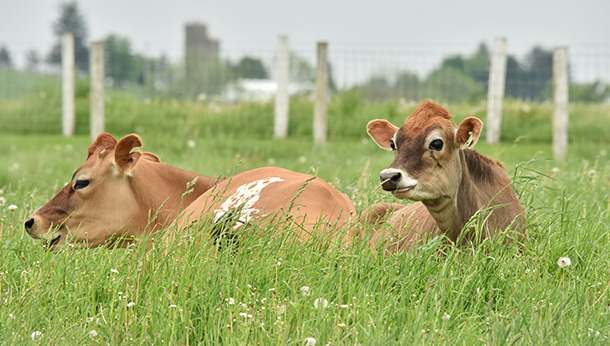
Clinical milk fever (hypocalcaemia) is a metabolic disorder caused by low blood calcium that effects on average 4 - 9% of dairy cows before and after calving. It costs farmers around £220 per cow that suffers with it and can be fatal, even with treatment. Subclinical milk fever can affect up to 60% of cows in a herd. Signs can be vague and include fertility issues, mastitis, metritis, reduced milk yields and displaced abomasums.
Shortly before giving birth, cows mobilise calcium from their body reserves, in for example bones, to supply the increasing demands of their body. They need large amounts of calcium to produce the colostrum – calcium levels in colostrum are 8-10 times greater than that in the blood supply. Needing this amount of calcium from a standing start puts the body under pressure and calcium levels in the blood can fall dangerously low.
High yield cows, Channel Island breeds and cows entering their third lactation are more susceptible to milk fever but heifers are rarely affected.
Fat cows are also more susceptible because their feed and calcium intakes are higher and they normally have a high milk yield. It may seem counterintuitive but feeding a high calcium diet in the two weeks before calving can contribute to milk fever. This is because a cows’ metabolism can become lazy and fail to mobilise the calcium from the stores around the body. Cows can gather more calcium from their stores than they can from feed. At calving the huge demands of milk production can take her metabolism by surprise leading to milk fever.
Symptoms
In most cases, the cow may seem excitable and twitchy. There may be tremors on the skin along the flanks, head and triceps.
This excitability rapidly changes to being dull and the cow may become unable to stand. Quite often they will stagger as if drunk and go down into a sitting position with a ‘kink’ in the neck.
The cow may have a dry nose, be staring into the distance with cold ears and legs. Her heart rate may seem weaker and faster and her body temperature may drop, especially in cold, wet and windy weather.
Finally, she may lie flat on her side. This is the last stage of symptoms, after which she may suffer from complete circulatory failure, slip into a coma and die.
Lasting Effects
1 in 20 cows with milk fever will die. Cows that have had milk fever are more susceptible – 1 in 3 cows that have had it in the past will get it again.
It can also cause infertility, mastitis, metritis and issues with milk yield in the future.
For every case of clinical milk fever, there are 3 - 6 cases of subclinical milk fever.
Treatment
Immediate help is needed to correct the cow’s blood calcium levels. As soon as you notice the signs described above, call your vet.
They will administer a slow intravenous infusion of calcium that has been warmed up to body temperature so as not to shock the system.
It’s good practice to sit her up in a sternal recumbent position and turn her so she is on the opposite side to the side she was found on and turn her every two hours to try to combat other complications such as bloat and muscle necrosis
Making sure she is protected from weather conditions is important and has access to water. In severe cases, your vet will suggest removing the calf.
Strategy
Prevention is better than cure so, doing everything you can beforehand to prevent milk fever is the best strategy.
- Avoid breeding from cows or sires with a history of milk fever.
- Prevent your cows from getting over-fat and make sure they get plenty of exercise.
- Make sure her diet is sufficient in magnesium, >40g per day, in late pregnancy with long fibre included throughout.
- Her calcium intake needs to be less than 50g a day during her dry period. That way the system for maintaining calcium will be on full alert and kick in when there is trouble.
- Avoid stressing her.
- Manipulation of dietary cation-anion balance (DCAB) in the dry cow diet is key
Speak to your vet to come up with the best strategy for you and your herd to make sure they don’t suffer with milk fever.